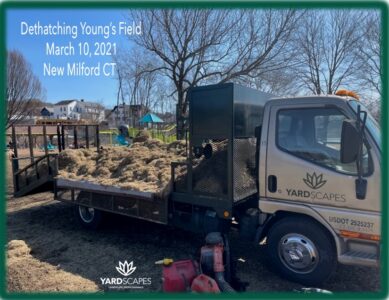Thatch is the layer of living and dead stems, roots, and crowns that forms a type of blanket over the soil of your lawn. A small amount of thatch (one-half inch or less) is acceptable and even good for the lawn. But when thatch accumulates to over one-half inch, it can become one of a lawn’s most serious enemies.
 KEEPS OUT THE GOOD & PROTECTS THE BAD – Like an old-time thatched roof, the thatch on your lawn creates a barrier which prevents the free movement of water, air, fertilizer, and insect controls into the soil. Since thatch is an ideal breeding ground for many diseases and turf-destroying insects, a heavy thatch layer can quickly become a serious problem.
KEEPS OUT THE GOOD & PROTECTS THE BAD – Like an old-time thatched roof, the thatch on your lawn creates a barrier which prevents the free movement of water, air, fertilizer, and insect controls into the soil. Since thatch is an ideal breeding ground for many diseases and turf-destroying insects, a heavy thatch layer can quickly become a serious problem.
GRASS CLIPPINGS NOT TO BLAME – Contrary to popular belief, grass clippings are not the prime cause of thatch build-up. Clippings are almost all water. Once dried, clippings add very little bulk to the thatch layer. Thatch is mainly made up of the heavier crowns, stems and roots. Clippings of moderate length can be left on the lawn without fear of quickly increasing the thatch layer.
REDUCES LAWN CARE EFFECTIVENESS – Heavy thatch prevents fertilizer and water from reaching the grass roots. This can result in a lawn that is thin, off-color, and prone to disease, insect, and drought problems.
You have two choices. – You can ignore the thatch, and hope it will decay before it does any harm. However, a thatch problem will almost always get worse with time, not better.
The second alternative – the option we most often recommend – is core aeration because it offers the least amount of disturbance to the healthy plants.
CORE AERATION – Simply put, core aeration is the mechanical removal of a small core of soil and thatch.
Core aeration benefits your lawn in three important ways: (1) it breaks through dense thatch and opens up the soil to permit free movement of water, fertilizer and air, (2) by extracting cores from every square foot of your lawn, core aeration relieves soil compaction and gives grass roots room to grow; (3) the soil cores break down and integrate into the thatch to speed up its decomposition.
Just one good core aeration can actually shrink your lawn’s water bill by as much as 50%. The reason is simple. With a heavy thatch build-up, most of the water sprinkled on the grass rims off your lawn, and down the street. Once we’ve core aerated, though, you’ll find that water run-off is all but eliminated – a lot less water will go a long way.
Another benefit is a stronger stand of grass. Roots will dig deeper into the soil and spread farther. This will help your lawn survive stress times of drought, high temperatures and normal foot traffic.
But of course the most important result of core aeration is a healthier, more beautiful, more lasting lawn.
Core aerate at least once a year. Bringing up cores is one of the most important forms of preventive maintenance you can give your lawn, and should be done at least once a year. Some lawns need to have this done twice a year. Talk to us – we’ll recommend the schedule that will help to relieve your thatch and compaction problems.
The plugs will disappear. Once core aerated, your lawn will be dotted with the little plugs we’ve pulled from the soil. These plugs will break apart and disappear into the lawn within a week or two.
© 1991 Focal Point Communications
© Ryan Turf-Care Equipment.
If you need more help or information with this topic or any other lawn or tree care questions, please contact us.
